The Evolution of Airline Regulation, Deregulation, and Reregulation
VerifiedAdded on 2019/09/21
|5
|1210
|485
Essay
AI Summary
This essay provides a comprehensive analysis of the regulatory landscape within the aviation industry, focusing on the periods of regulation, deregulation, and reregulation. It begins by highlighting the importance of government intervention, especially during economic downturns, and the establishment of the Federal Aviation Commission (FAC) to ensure safety and economic stability. The essay then delves into the role of the Civil Aviation Board (CAB) in regulating the internal air transport market, including route allocation, tariff regulations, and antitrust measures. The impact of deregulation in 1978 is explored, detailing its effects on competition, consumer choices, and market dynamics. Furthermore, the essay examines the consequences of deregulation, including market instability, airline bankruptcies, and the consolidation of major airlines. It also discusses the challenges faced by the industry, such as infrastructure taxes and the increasing age of aircraft, while providing insights into the ongoing monitoring of the US market and its implications. The paper uses references to support the arguments.
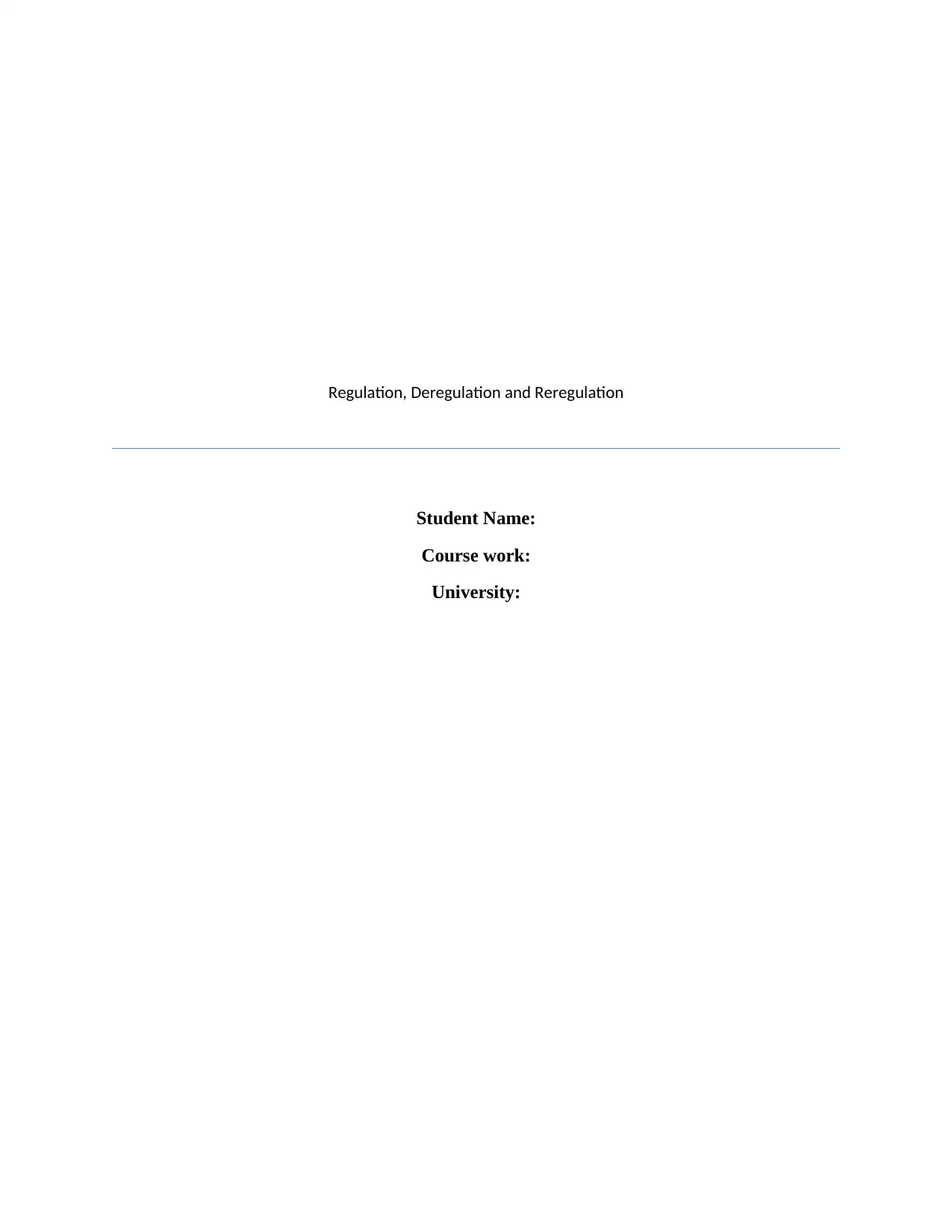
Regulation, Deregulation and Reregulation
Student Name:
Course work:
University:
Student Name:
Course work:
University:
Paraphrase This Document
Need a fresh take? Get an instant paraphrase of this document with our AI Paraphraser
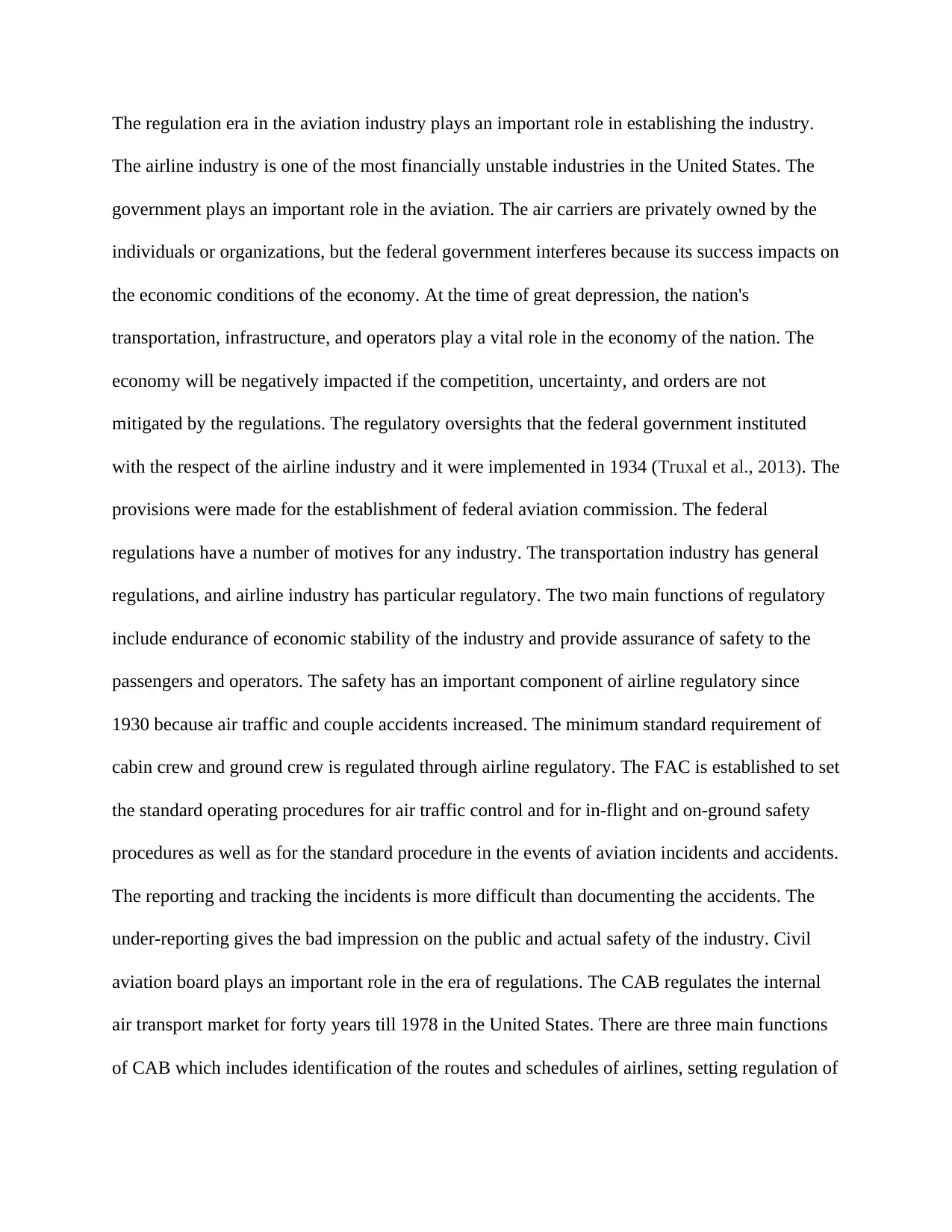
The regulation era in the aviation industry plays an important role in establishing the industry.
The airline industry is one of the most financially unstable industries in the United States. The
government plays an important role in the aviation. The air carriers are privately owned by the
individuals or organizations, but the federal government interferes because its success impacts on
the economic conditions of the economy. At the time of great depression, the nation's
transportation, infrastructure, and operators play a vital role in the economy of the nation. The
economy will be negatively impacted if the competition, uncertainty, and orders are not
mitigated by the regulations. The regulatory oversights that the federal government instituted
with the respect of the airline industry and it were implemented in 1934 (Truxal et al., 2013). The
provisions were made for the establishment of federal aviation commission. The federal
regulations have a number of motives for any industry. The transportation industry has general
regulations, and airline industry has particular regulatory. The two main functions of regulatory
include endurance of economic stability of the industry and provide assurance of safety to the
passengers and operators. The safety has an important component of airline regulatory since
1930 because air traffic and couple accidents increased. The minimum standard requirement of
cabin crew and ground crew is regulated through airline regulatory. The FAC is established to set
the standard operating procedures for air traffic control and for in-flight and on-ground safety
procedures as well as for the standard procedure in the events of aviation incidents and accidents.
The reporting and tracking the incidents is more difficult than documenting the accidents. The
under-reporting gives the bad impression on the public and actual safety of the industry. Civil
aviation board plays an important role in the era of regulations. The CAB regulates the internal
air transport market for forty years till 1978 in the United States. There are three main functions
of CAB which includes identification of the routes and schedules of airlines, setting regulation of
The airline industry is one of the most financially unstable industries in the United States. The
government plays an important role in the aviation. The air carriers are privately owned by the
individuals or organizations, but the federal government interferes because its success impacts on
the economic conditions of the economy. At the time of great depression, the nation's
transportation, infrastructure, and operators play a vital role in the economy of the nation. The
economy will be negatively impacted if the competition, uncertainty, and orders are not
mitigated by the regulations. The regulatory oversights that the federal government instituted
with the respect of the airline industry and it were implemented in 1934 (Truxal et al., 2013). The
provisions were made for the establishment of federal aviation commission. The federal
regulations have a number of motives for any industry. The transportation industry has general
regulations, and airline industry has particular regulatory. The two main functions of regulatory
include endurance of economic stability of the industry and provide assurance of safety to the
passengers and operators. The safety has an important component of airline regulatory since
1930 because air traffic and couple accidents increased. The minimum standard requirement of
cabin crew and ground crew is regulated through airline regulatory. The FAC is established to set
the standard operating procedures for air traffic control and for in-flight and on-ground safety
procedures as well as for the standard procedure in the events of aviation incidents and accidents.
The reporting and tracking the incidents is more difficult than documenting the accidents. The
under-reporting gives the bad impression on the public and actual safety of the industry. Civil
aviation board plays an important role in the era of regulations. The CAB regulates the internal
air transport market for forty years till 1978 in the United States. There are three main functions
of CAB which includes identification of the routes and schedules of airlines, setting regulation of
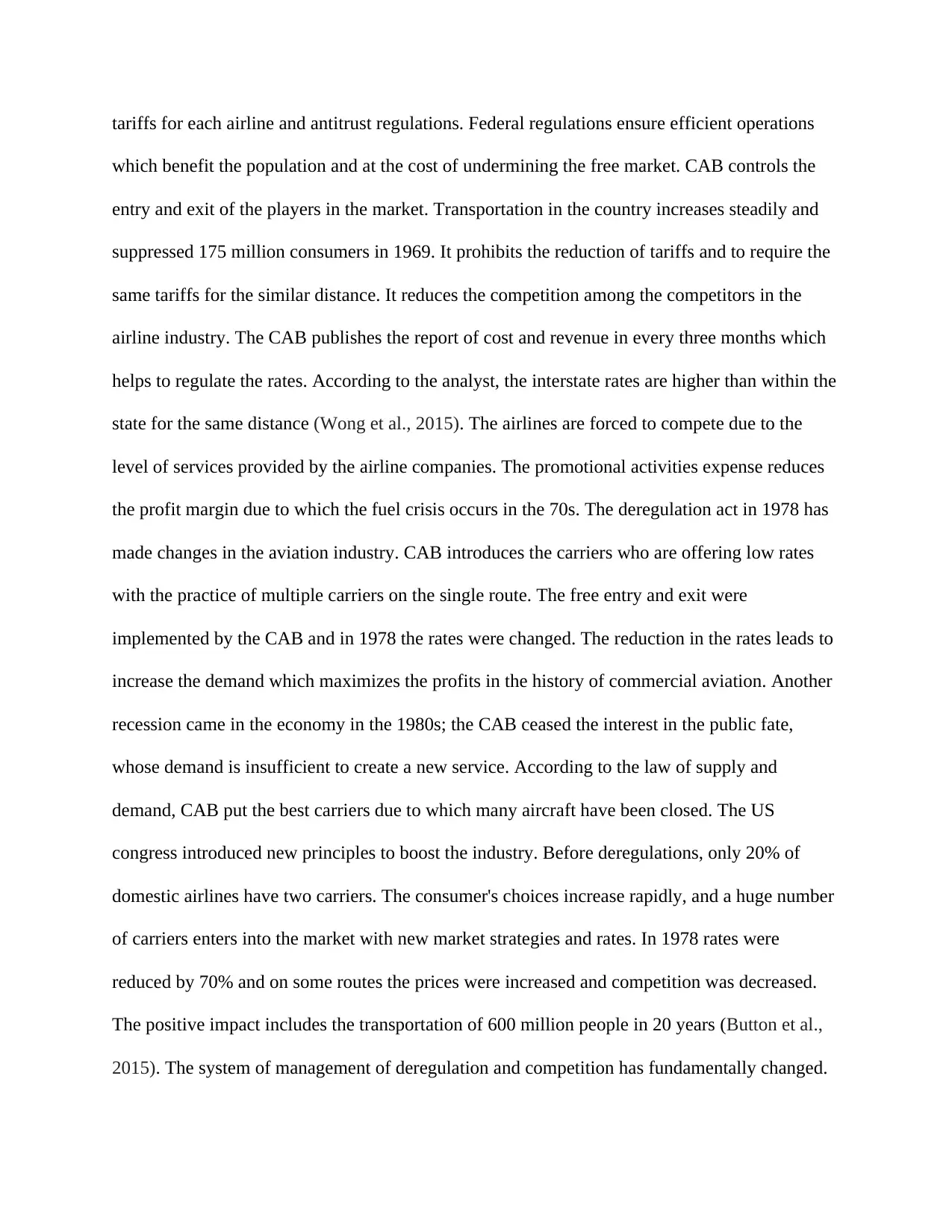
tariffs for each airline and antitrust regulations. Federal regulations ensure efficient operations
which benefit the population and at the cost of undermining the free market. CAB controls the
entry and exit of the players in the market. Transportation in the country increases steadily and
suppressed 175 million consumers in 1969. It prohibits the reduction of tariffs and to require the
same tariffs for the similar distance. It reduces the competition among the competitors in the
airline industry. The CAB publishes the report of cost and revenue in every three months which
helps to regulate the rates. According to the analyst, the interstate rates are higher than within the
state for the same distance (Wong et al., 2015). The airlines are forced to compete due to the
level of services provided by the airline companies. The promotional activities expense reduces
the profit margin due to which the fuel crisis occurs in the 70s. The deregulation act in 1978 has
made changes in the aviation industry. CAB introduces the carriers who are offering low rates
with the practice of multiple carriers on the single route. The free entry and exit were
implemented by the CAB and in 1978 the rates were changed. The reduction in the rates leads to
increase the demand which maximizes the profits in the history of commercial aviation. Another
recession came in the economy in the 1980s; the CAB ceased the interest in the public fate,
whose demand is insufficient to create a new service. According to the law of supply and
demand, CAB put the best carriers due to which many aircraft have been closed. The US
congress introduced new principles to boost the industry. Before deregulations, only 20% of
domestic airlines have two carriers. The consumer's choices increase rapidly, and a huge number
of carriers enters into the market with new market strategies and rates. In 1978 rates were
reduced by 70% and on some routes the prices were increased and competition was decreased.
The positive impact includes the transportation of 600 million people in 20 years (Button et al.,
2015). The system of management of deregulation and competition has fundamentally changed.
which benefit the population and at the cost of undermining the free market. CAB controls the
entry and exit of the players in the market. Transportation in the country increases steadily and
suppressed 175 million consumers in 1969. It prohibits the reduction of tariffs and to require the
same tariffs for the similar distance. It reduces the competition among the competitors in the
airline industry. The CAB publishes the report of cost and revenue in every three months which
helps to regulate the rates. According to the analyst, the interstate rates are higher than within the
state for the same distance (Wong et al., 2015). The airlines are forced to compete due to the
level of services provided by the airline companies. The promotional activities expense reduces
the profit margin due to which the fuel crisis occurs in the 70s. The deregulation act in 1978 has
made changes in the aviation industry. CAB introduces the carriers who are offering low rates
with the practice of multiple carriers on the single route. The free entry and exit were
implemented by the CAB and in 1978 the rates were changed. The reduction in the rates leads to
increase the demand which maximizes the profits in the history of commercial aviation. Another
recession came in the economy in the 1980s; the CAB ceased the interest in the public fate,
whose demand is insufficient to create a new service. According to the law of supply and
demand, CAB put the best carriers due to which many aircraft have been closed. The US
congress introduced new principles to boost the industry. Before deregulations, only 20% of
domestic airlines have two carriers. The consumer's choices increase rapidly, and a huge number
of carriers enters into the market with new market strategies and rates. In 1978 rates were
reduced by 70% and on some routes the prices were increased and competition was decreased.
The positive impact includes the transportation of 600 million people in 20 years (Button et al.,
2015). The system of management of deregulation and competition has fundamentally changed.
⊘ This is a preview!⊘
Do you want full access?
Subscribe today to unlock all pages.

Trusted by 1+ million students worldwide
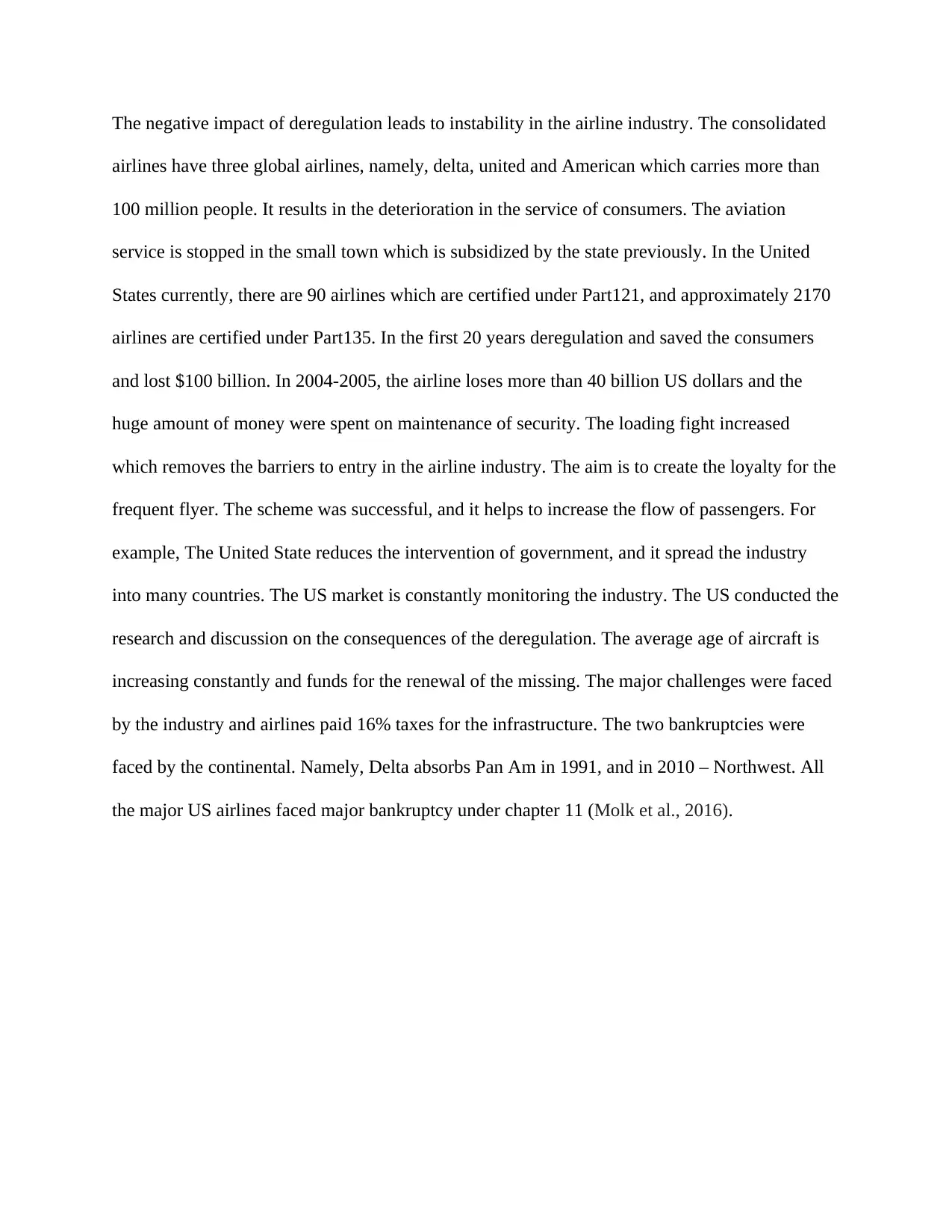
The negative impact of deregulation leads to instability in the airline industry. The consolidated
airlines have three global airlines, namely, delta, united and American which carries more than
100 million people. It results in the deterioration in the service of consumers. The aviation
service is stopped in the small town which is subsidized by the state previously. In the United
States currently, there are 90 airlines which are certified under Part121, and approximately 2170
airlines are certified under Part135. In the first 20 years deregulation and saved the consumers
and lost $100 billion. In 2004-2005, the airline loses more than 40 billion US dollars and the
huge amount of money were spent on maintenance of security. The loading fight increased
which removes the barriers to entry in the airline industry. The aim is to create the loyalty for the
frequent flyer. The scheme was successful, and it helps to increase the flow of passengers. For
example, The United State reduces the intervention of government, and it spread the industry
into many countries. The US market is constantly monitoring the industry. The US conducted the
research and discussion on the consequences of the deregulation. The average age of aircraft is
increasing constantly and funds for the renewal of the missing. The major challenges were faced
by the industry and airlines paid 16% taxes for the infrastructure. The two bankruptcies were
faced by the continental. Namely, Delta absorbs Pan Am in 1991, and in 2010 – Northwest. All
the major US airlines faced major bankruptcy under chapter 11 (Molk et al., 2016).
airlines have three global airlines, namely, delta, united and American which carries more than
100 million people. It results in the deterioration in the service of consumers. The aviation
service is stopped in the small town which is subsidized by the state previously. In the United
States currently, there are 90 airlines which are certified under Part121, and approximately 2170
airlines are certified under Part135. In the first 20 years deregulation and saved the consumers
and lost $100 billion. In 2004-2005, the airline loses more than 40 billion US dollars and the
huge amount of money were spent on maintenance of security. The loading fight increased
which removes the barriers to entry in the airline industry. The aim is to create the loyalty for the
frequent flyer. The scheme was successful, and it helps to increase the flow of passengers. For
example, The United State reduces the intervention of government, and it spread the industry
into many countries. The US market is constantly monitoring the industry. The US conducted the
research and discussion on the consequences of the deregulation. The average age of aircraft is
increasing constantly and funds for the renewal of the missing. The major challenges were faced
by the industry and airlines paid 16% taxes for the infrastructure. The two bankruptcies were
faced by the continental. Namely, Delta absorbs Pan Am in 1991, and in 2010 – Northwest. All
the major US airlines faced major bankruptcy under chapter 11 (Molk et al., 2016).
Paraphrase This Document
Need a fresh take? Get an instant paraphrase of this document with our AI Paraphraser
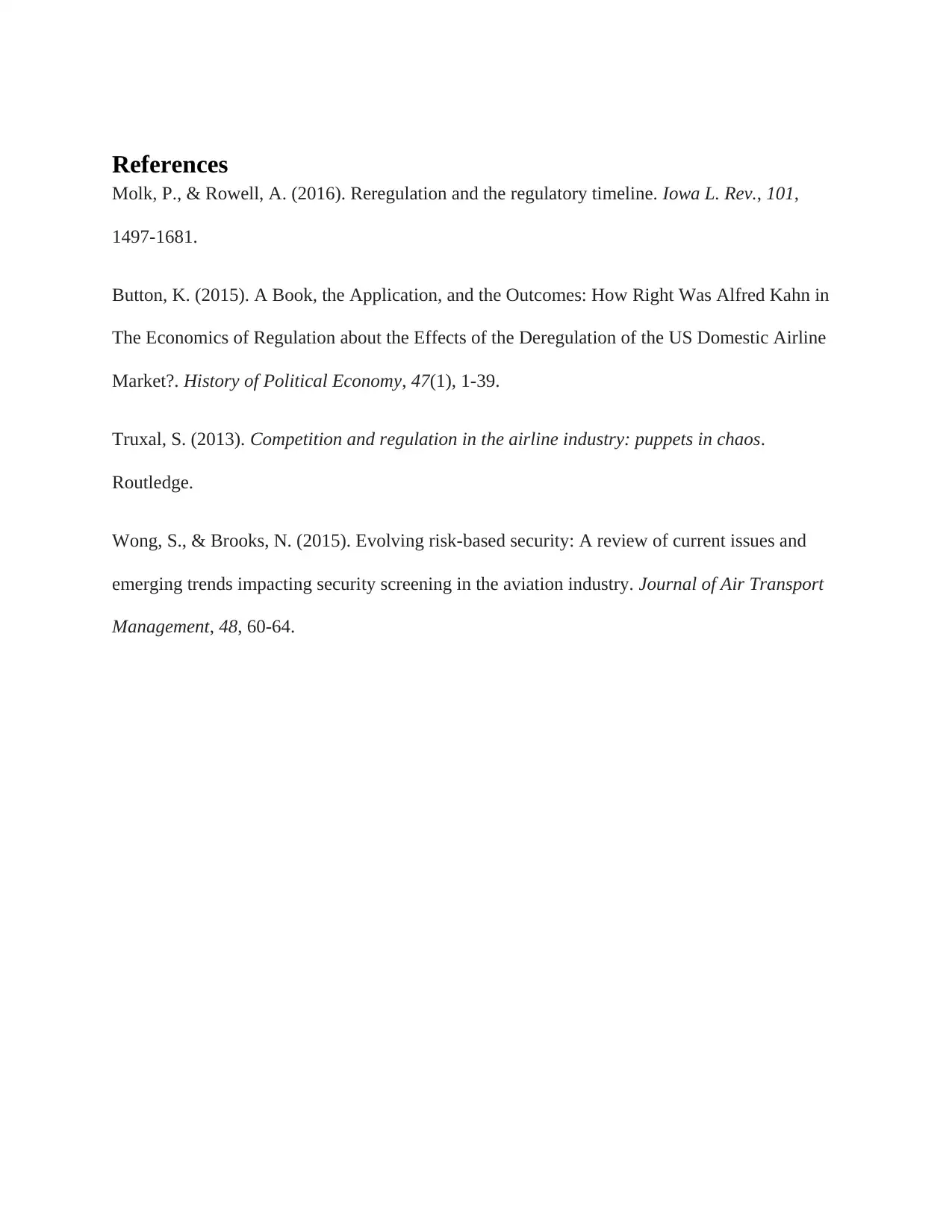
References
Molk, P., & Rowell, A. (2016). Reregulation and the regulatory timeline. Iowa L. Rev., 101,
1497-1681.
Button, K. (2015). A Book, the Application, and the Outcomes: How Right Was Alfred Kahn in
The Economics of Regulation about the Effects of the Deregulation of the US Domestic Airline
Market?. History of Political Economy, 47(1), 1-39.
Truxal, S. (2013). Competition and regulation in the airline industry: puppets in chaos.
Routledge.
Wong, S., & Brooks, N. (2015). Evolving risk-based security: A review of current issues and
emerging trends impacting security screening in the aviation industry. Journal of Air Transport
Management, 48, 60-64.
Molk, P., & Rowell, A. (2016). Reregulation and the regulatory timeline. Iowa L. Rev., 101,
1497-1681.
Button, K. (2015). A Book, the Application, and the Outcomes: How Right Was Alfred Kahn in
The Economics of Regulation about the Effects of the Deregulation of the US Domestic Airline
Market?. History of Political Economy, 47(1), 1-39.
Truxal, S. (2013). Competition and regulation in the airline industry: puppets in chaos.
Routledge.
Wong, S., & Brooks, N. (2015). Evolving risk-based security: A review of current issues and
emerging trends impacting security screening in the aviation industry. Journal of Air Transport
Management, 48, 60-64.
1 out of 5
Related Documents
Your All-in-One AI-Powered Toolkit for Academic Success.
+13062052269
info@desklib.com
Available 24*7 on WhatsApp / Email
![[object Object]](/_next/static/media/star-bottom.7253800d.svg)
Unlock your academic potential
Copyright © 2020–2025 A2Z Services. All Rights Reserved. Developed and managed by ZUCOL.





